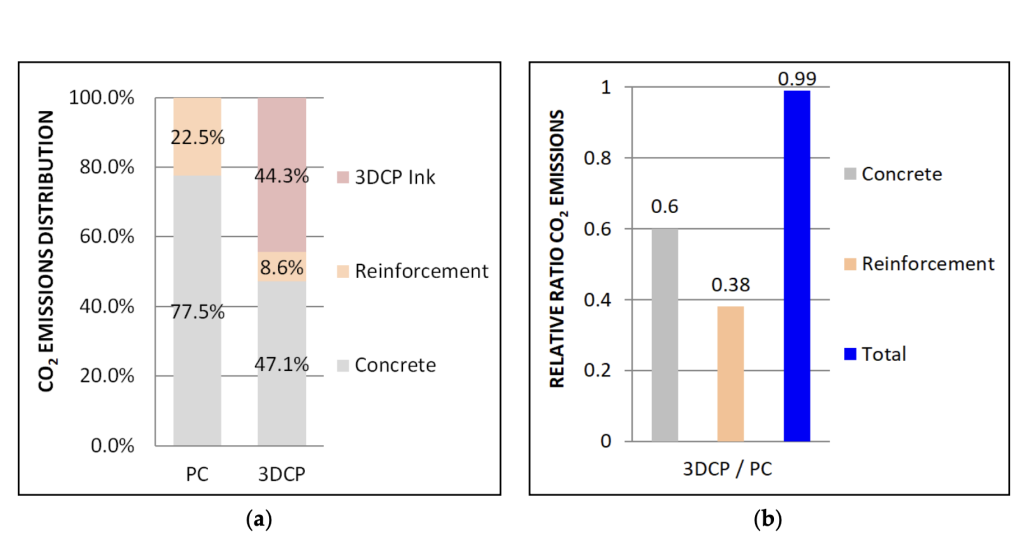Researchers at Heriot-Watt University have published a study that casts doubt on some of the benefits that concrete 3D printing is widely-believed to offer over conventional construction methods.
In their study, the researchers found that if a two-storey structure built using traditional precast concrete in the UAE had been 3D printed instead, contractors wouldn’t have been able to achieve the expected efficiency gains. On the contrary, the team discovered that switching to 3D printing would’ve raised the project’s material costs by 44%, while only yielding a tiny sustainability improvement.

3D printing: a housing solution?
With the ongoing disruption caused by COVID-19 and Russia’s invasion of Ukraine showing no signs of abating, the ‘cost-of-living crisis’ being seen in parts of the Western world is only likely to get worse. For those unfamiliar with the phrase, it describes conditions under which high inflation outstrips any rises in wages or state benefits, leading to a decline in people’s disposable incomes, that is in real-terms.
You could justifiably ask, what does this have to do with 3D printing? Well, a decline in spending power only serves to raise the bar to homeownership, something that for many, already necessitates saving, then decades of spending on a mortgage.
One solution that’s often proposed to the high cost of building new homes, is adopting ‘digital construction,’ a modern approach that relies on AI, robotics and more often than not, 3D printing. Advocates of digital construction say the process, across its many different guises, brings a high level of automation (and therefore efficiency) to building sites, while enabling the use of less reinforcement materials.
It’s this material frugality that has often grabbed the headlines in recent months, with many researchers seeking to prove the technology’s sustainability via case studies. Earlier this year, an IIT Guwahati team 3D printed furniture from industrial waste, while in the wider industry, firms like Apis Cor have committed to new affordable housing projects.
However, according to the Heriot-Watt researchers, the benefits of digital construction are rarely compared directly with those of traditional construction, in a specific end-use application. To rectify this, the team has therefore launched an investigation into what the consequences would have been, if a townhouse built via a common precast construction method in the UAE, was 3D printed instead.

Coming to challenging conclusions
While various construction 3D printing methods currently exist, for the sake of their hypothetical build, the researchers chose to use a gantry-based contour crafting system and a concrete rheologically-optimized for use with the technology. Once they’d established the parameters of their experiment, the team assessed the potential cost, efficiency and sustainability impact it would have in practice.
Interestingly, while the study revealed that concrete 3D printing was 34 working hours quicker than traditional construction methods, it only proved 1% more efficient. This, the researchers found, was due to the “high carbon footprint” of the 3D printing materials used as an alternative to concrete, thus, despite the ink containing 39.1% less concrete than normal cement, it was still as unsustainable.
The team’s surprising results were compounded by their cost findings, which revealed that completing the build using 3D printing, would have been around 5% more expensive than the way it was erected initially. In particular, the high cost of compatible materials was raised as an issue pushing the process’ price up, as these were responsible for some 22% of the structure’s projected expenditure.
On the flipside, the researchers’ calculations also factor-in 3D printer rental costs, which would account for 37% of the project’s total, therefore buying one outright for carrying out builds would arguably reduce the price-per-structure significantly. Even so, the team wrapped up their paper by calling for further comparative studies, and more research into potential process optimization opportunities.
“It is recommended that further research is to be conducted,” conclude the team in their paper. “A comparative study between concrete 3D printing and a cast-in-place technique where formwork, brick and mortar walls are in use is recommended. These recommendations are significant to understand the impact of the technology in reducing the CO2 emissions of concrete production and the cost of mass housing construction.”
Moving forwards with materials
Another aspect that could well have changed the outcome of the researchers’ study, is the formulation of their 3D printing concrete, something that’s now being investigated on multiple fronts elsewhere. Working with COBOD, for example, CEMEX has come up with a concrete that gains shape instantaneously upon deposition, before deploying it to construct Angola’s first-ever 3D printed home.
Similarly, in India, Tvasta Manufacturing Solutions has partnered with India Cements to develop a more sustainable construction 3D printing material. As part of a recent ‘strategic collaboration’ deal, the firms have agreed to exchange technologies and conduct joint R&D, in order to make construction in the country less wasteful.
ICE Industrial Services, which plans on using 3D printing to help rebuild Ukraine, has also developed its own custom concrete 3D printing formulation. Concocted alongside the Brno University of Technology, the material is said to be one of the USPs of the system the firm has come up with to assist in the reconstruction of Ukraine’s border posts.
The researchers’ findings are detailed in their paper titled “3D Concrete Printing for Sustainable & Affordable Housing Construction-Comparative Study,” which was co-authored by Mustafa Batikha and Moiz Ul Fazal.
To stay up to date with the latest 3D printing news, don’t forget to subscribe to the 3D Printing Industry newsletter or follow us on Twitter or liking our page on Facebook.
For a deeper dive into additive manufacturing, you can now subscribe to our Youtube channel, featuring discussion, debriefs, and shots of 3D printing in-action.
Are you looking for a job in the additive manufacturing industry? Visit 3D Printing Jobs for a selection of roles in the industry.
Featured image shows a rendering of DEWA’s 3D printed R&D Centre. Image via DEWA.



